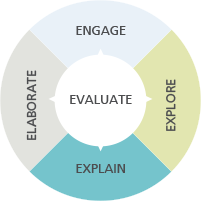The Norwegian Council for Road Safety’s Model for Behaviour Modification (see this example as part of Principle #11) promotes the so-called 5E model, which is a tool to support teachers in planning, implementation and evaluation of learning for the actively participating pupil. It is called the 5E model because all five pedagogical concepts start with the letter E: engage, explore, explain, elaborate, evaluate.

The word ‘evaluate’ is placed in the centre of the model because the purpose of the evaluation is to promote learning, and because evaluation occurs in all phases of teaching. The term evaluation covers three types of assessment: continuous evaluation (formative assessment), final evaluation (summative assessment) and self-assessment.
Evaluations must be conducted continuously, be varied and a natural part of the instruction given. It can be given orally and in writing. The pupils are to evaluate their own learning and understanding, as well as the quality of their own work. The teacher is to evaluate the pupils’ learning in relation to the learning outcomes in a given topic or project. The evaluation is to be related to the objectives in the curriculum, and it must provide feedback that supports the pupils’ learning.
More Information
Trygg Trafikk (2017), The Norwegian Council for Road Safety’s model for behaviour modification.